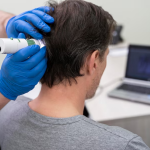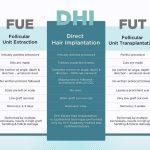Male Pattern Baldness – Causes, Stages & Treatment Available at DHI
Hair loss has become one of the common issues faced by individuals whether these are related to hair thinning, receding hairline, or bald patches. Specifically, in the case of male pattern baldness, this hair loss issue starts as a bald patch on the head. Also known as androgenetic alopecia, male pattern baldness is characterized by a specific pattern of hair thinning and loss. It starts from the temple and affects the crown area further leading to a receding line. Here’s a comprehensive overview of male pattern baldness.
What is male pattern baldness?
Male Pattern Baldness is exclusively associated with the hair loss issue experienced by men. This common hair loss problem starts as a receding hairline and hair thinning, thereby, turning into bald patches on the scalp. If you think this is natural due to the age factor and do not require treatment, then, it should be highlighted that your personality will get accentuated after the hair loss treatment. Most of the time, the signs of male pattern baldness can be witnessed at the age of 50. But, sometimes, during the late teens or early twenties, this hair loss. In the initial stage, hair rejuvenation or regrowth supplements can be prescribed. However, if the receding hairline has exceeded the limit of cure through serums or supplements, then, the advanced treatment has to be availed.
Whether it is the use of FDA-approved medications or counting on laser-assisted hair restoration, the hair specialist understands the case and the patient’s hair loss history during the consultation. Uncovering the root cause or multiple reasons leading to male pattern baldness is essential to recommend the best treatment.
Male Pattern Baldness – Causes, Stages & Treatment
Generally, stress & and anxiety, nutritional deficiencies, and lifestyle habits contribute to the root causes of male pattern baldness. Nevertheless, age, genetics, and hormones are likely to contribute to this hair loss condition. In terms of genetic factors, the inheritance of certain genes acts as the major factor in the development of male pattern hair loss. On the other hand, dihydrotestosterone (DHT) causes the shrinkage of hair follicles and results in stunted hair growth. Similarly, the estrogen hormone can reverse male pattern baldness. It must be highlighted that despite the reduction of DHT level when you grow old, the hair loss persists and may aggravate if it does not get addressed promptly. Following are some of the other reasons behind hair loss:
-
Environmental conditions
Environmental issues pose a threat to hair health through hair fall. When the hair fall persists, it leads to baldness. Moreover, the overall health of an individual also gets impacted due to the environmental imbalance.
-
Lack of nutrients in the daily diet
From the proper intake of Vitamins- A, C, D & and E, Zinc, Biotin, iron, and protein to essential acids, healthy hair growth needs to be managed through a nutritious diet. On the contrary, when insufficient nutritive value is not supplied to the hair daily, hair loss issues are experienced.
-
Long-term illness
Male Pattern Hair Loss or Baldness can also be caused due to some long-term health disorders including, high blood pressure, prostate cancer, polycystic ovary syndrome (PCOS), cardiac issues, etc.
Other causes of male pattern baldness
In addition, thyroid issues, hormonal imbalances, and certain medications lead to complications in the hair loss signs. These early signs should be treated seriously and a proper consultation for male pattern baldness will offer a customized hair restoration solution. Let us dive a little deeper to understand male pattern baldness – causes, stages & and treatment available at DHI.
Diagnosis of Male Pattern Hair loss or Baldness
When you visit the hair care clinic to explore opportunities for hair restoration, the first phase is consultation. Since it is essential to diagnose the root cause before recommending the treatment, the trichologist evaluates your issue by gathering information related to hair loss issues, eating disorders, and lifestyle-related interruptions in hair growth. Alternatively, he also enquires about temporary hair loss, auto-immune health disorders, and other complaints related to hair loss. Whether it is the hair thinning, detection of early signs experienced in the male pattern baldness, or any major treatment like chemotherapy, you have gone through, the whole idea is to offer an evidence-based recommendation.
After it becomes apparent that you are eligible for hair restoration to treat male pattern baldness, the Norwood or Hamilton Norwood scale is used to measure the severity of the condition. Based on the observation hair transplant experts discuss the stages of male pattern baldness and treatment options available at DHI International. Being the leading hair transplant clinic with a worldwide presence, our holistic approach to hair restoration is transparent. All the details and stages of male pattern hair loss are discussed with the patient to help them understand the prospects through the surgical intervention. Here is a brief about the various stages of this condition of hair loss:
Stage 1: Hair thinning, but no visible signs of hair loss around the crown area.
Stage 2: Slight hair thinning around the temples with no visible crown hair loss.
Stage 3: Visible receding hairline (M, U, or V shape) with no signs of crown hair loss.
Stage 4: Hair loss spreads around temples and crown area, though hair density in the mid-scalp is not affected.
Stage 5: Hair loss in the crown and temple area becomes excessive.
Stage 6: Hair loss increases and the crown and temple hair loss meet. Hair remains in some parts or edges of the crown.
Stage 7: Maximum hair loss signs from the mid-scalp, crown, and temple area are witnessed.
You may not be able to realize whether this rapid hair loss is due to androgenetic alopecia in the initial stages. However, if you seek a consultation from DHI International, we will help you with the top solution tailored according to your preferences.
Treatment options for Male Pattern Baldness at DHI International
Among the various hair restoration techniques, we have emphasized the use of Direct Hair Implantation (DHI). This painless procedure of hair restoration is safe and leaves no scars. DHI offers 100% natural results and does not involve stitches. We use a patented implanter tool for the procedure that is performed by MD Dermatologist doctors. All our well-trained and certified doctors have completed their degrees from the London Hair Restoration Academy – the one & and only training academy in hair restoration. DHI International team ensures 100% safety, natural results, maximum viability, and lifetime growth.
Our 3-step procedure of hair restoration at DHI includes:
-
Extraction Phase
As a part of the initial phase of extraction, our professional surgeons use a disposable tool to extract hair follicles from the donor area. After the successful extraction, the follicles are stored in a solution at a specific temperature. This process is aimed at improving the quality of hair follicles for smooth placement in the recipient area without any mismatch.
-
Implantation
The hair follicles are implanted in the recipient area with the help of a patented DHI implanter. This tool with a diameter of 1mm or less may be used to create an incision by the surgeon or he may directly execute the DHI, hair transplant procedure.
-
Natural Results
With the help of the DHI hair transplant technique, due to the full control over the depth, direction, and angle of hair graft or follicle placement, DHI ensures 100% natural results. Besides, the guarantee of viable outcomes, never falling out of implanted hair, and consistent hair regrowth are offered by our clinic.
FAQs related to Male Pattern Baldness
Q1) Can I diagnose male pattern baldness at home?
Ans) Hair loss can be witnessed by the changes in the appearance and the pattern of hair loss. If you want to diagnose Male Pattern Baldness at home, then, a hair pull test and collecting and analyzing are the two options to consider:
Hair Pull Test: As a part of this test, a thick clump of hair needs to be grasped between the thumb and forefinger. The next step will be pulling the hair outward and away from the scalp gently. If you are suffering from male pattern baldness, then, up to 3-4 amounts of hair will be pulled as compared to normal adults without hair loss issues.
Collecting & and analyzing hair: Monitor sinks, hair brushes, and pillowcases for stray hair strands. Collect these hair strands in a separate case for over a week and the samples can be assessed by the professional trichologist at the clinic.
Even though, you can diagnose hair loss issues at home, it is advisable to seek professional consultation for the best recommendation after the diagnosis of male pattern baldness.
Q2) What is the recovery time after the DHI hair restoration procedure?
Ans) The patient is discharged on the same day after the DHI male pattern baldness treatment. We advise a 1–2-day rest to the individual who has undergone this effective and definite hair transplant procedure before resuming the normal routine. However, it takes up to 2-3 days for healing and one should follow the care instructions advised by our doctor after the DHI procedure for smooth recovery. In terms of results, the final state of hair can be witnessed after 8-12 months of the Direct Hair Implantation – DHITM hair transplant technique.
For a detailed overview regarding Male Pattern Baldness – Causes, Stages, and treatment Available at DHI, visit our clinic for a personalized treatment. Contact us to book a hair transplant appointment with one of our DHI International hair transplant specialists!







